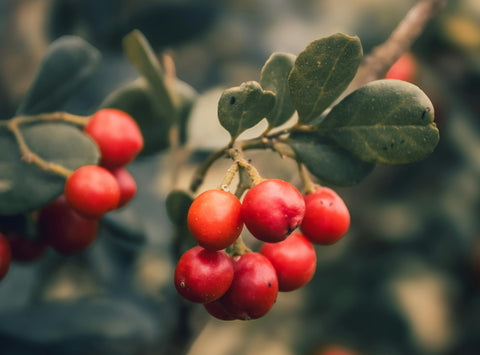November 24 is our “Did You Know?” day for nature’s quiet showoffs. Meet the cold bloomers. While most gardens nap, witch hazel ribbons into yellow fireworks, holly gleams with winter berries, and snowberry dots bare stems with pearl white fruit. These plants remind us that life hums along even when the air feels crisp. And yes, with a little biofeedback, they still make music you can hear.
If you are craving a shareable, feel good piece of science and beauty, this is your moment. We will keep it visual, practical, and lightly nerdy. We will peek at antifreeze proteins, pollinators who fly on sunny winter days, and how PlantChoir lets you listen to the subtle bio signals of cold season stars. By the end, you will know which plants to photograph, what to listen for, and how to bring a short plant sound clip into your feed. Because the healthiest soundtrack sometimes arrives on frosty mornings.
Cold bloomers at a glance
Cold blooming is not magic. It is strategy. Plants prepare for low temperatures with smart chemistry and structure. Some even flower when most insects sleep, banking on the few that wake during bright winter hours. Before we zoom into the science, meet three familiar faces.
Witch hazel

American witch hazel, Hamamelis virginiana, unfurls crimped yellow petals from October into December in much of North America. The show can last several weeks and often peaks in mid October through mid November. On calm days the flowers give off a spicy, citrus scent. If the weather turns icy, the petals curl up like tiny springs and unfurl again when it warms. A wise strategy for a shrub that dares to bloom while most plants wrap up for the year.
Fun pollination note
Late season visitors include small flies and bees that forage when the sun nudges the thermometer upward. Studies and field reports suggest flies are frequent visitors and likely part of the pollination story. Winter pollination is tricky, yet witch hazel has been making it work for ages.
Holly

Holly’s flowers appear in late spring, not winter. So why include it here? Because holly carries the season visually. It blooms in May or June, then female plants set bright berries that persist into the cold months. Those glossy leaves and red fruits are the reason holly stars in winter decor. If you spot bees on holly, that is spring. If you photograph berries in snow, that is winter’s beauty at work.
Snowberry

Snowberry, Symphoricarpos albus, blooms in early summer with small, bell shaped flowers. The berries that follow are the headline. They ripen by fall and often hang on bare twigs through winter, little snowballs on sticks. Not a winter bloomer, yet a true winter scene stealer that pairs perfectly with witch hazel in photos and nature walks.
Bottom line
For your late fall and early winter stories, let witch hazel carry the “bloom now” banner. Let holly and snowberry bring vivid fruit and form. Together they create the cold weather palette that makes people stop scrolling and start breathing.
How plants face the cold
When temperatures dip, cells face two big risks. Water can freeze into sharp crystals that puncture membranes. Or the cell can lose water to ice outside the cell and collapse like a punctured tent. Cold hardy plants use a kit of tricks to avoid both.
Antifreeze proteins
“Antifreeze” is not just for cars. Many overwintering plants produce antifreeze proteins that bind to tiny ice crystals and keep them from growing into cell shredding shards. These proteins can also lower the temperature at which ice grows, a phenomenon known as thermal hysteresis. According to plant biochemists, antifreeze proteins help slow ice formation and protect cell structure during freeze and thaw cycles.
Dehydrins
Plants also call in dehydrins, a family of flexible, protective proteins. Dehydrins act like soft packing foam inside cells. They stabilize membranes and proteins when water is scarce or freezing. Because dehydrins are intrinsically disordered, they do not denature the way many proteins do when stressed. Researchers point to dehydrins as repeat helpers during cold, drought, and salt stress.
Supercooling and ice management
Some buds and tissues avoid ice altogether by supercooling. Water inside stays liquid below the normal freezing point until a trigger causes ice to form. Other tissues allow ice to form outside the cells, gently pulling water outward while keeping the fragile inner life intact. In temperate trees and shrubs, scientists have documented buds that supercool while pushing ice to safer locations in surrounding tissues. Both strategies keep delicate structures safe until spring.
Why this matters for you
Those branches that look still are doing complex work. The chemistry and physics of cold tolerance are happening right now on your neighborhood walk. When witch hazel gambles on a November bloom, its tissues are already tuned for cold nights and sunny afternoons.
What to watch with your camera
Cold bloomers reward patient eyes. Aim for macro shots that show detail without fuss. Here are visual cues that pop on social and in print.
-
Witch hazel petals
Look for long, ribbon like petals that twist and curl. Capture how they retract in frost and unfurl in sun. -
Holly berries
Frame glossy green against scarlet fruit. A shallow depth of field makes berries glow. -
Snowberry clusters
Zoom in on the matte white spheres against dark twigs. A light dusting of snow turns it into a postcard. -
Buds and ice
Use morning light to catch ice beads on buds. It is a quiet nod to supercooling and ice management without the jargon.
Why they still sing in winter
Plants are not silent, even in the cold. They are always exchanging water, opening and closing stomata, and shifting internal charge. These tiny changes show up as bio electrical variability on the leaf surface. That is where PlantChoir comes in.
Turning cold season biology into sound
PlantChoir uses gentle, gold plated sensors to sense shifting plant bio signals and translates them into real time music. The device was built with high resolution sensing to reduce noise and reveal more nuance. Pair it to the PlantChoir app, choose from forty instruments and eight musical scales, and assign up to four instruments per plant. The result is a soundscape that evolves with the plant’s current state. Portable, water resistant, and designed for everyday play, PlantChoir runs four to six weeks on a charge and lets you record and share inside the app.
In winter, you will often hear slower, steadier patterns from outdoor shrubs on mild days. Indoors, your evergreen housemates maintain a quiet pulse that can feel grounding. Listeners often describe a relaxed, present mood while the music plays. It is not a medical claim. It is a mindful, creative way to pay attention.
Light neuroscience to anchor the mood
Part of the charm here is how you feel during and after a session. Environmental psychologists call it attention restoration. Gentle contact with nature provides “soft fascination” that lets directed attention rest and refill. You are not zoning out. You are letting your mind idle in a healthy way, which often helps focus later. When paired with natural or nature inspired sound, many people recover from everyday stress more smoothly. According to studies and reviews, time with nature supports mood and cognition, while nature sounds can aid post stress recovery in lab tests.
Use that science as a quiet aside in your caption or video voiceover
“Soft fascination is real. A few minutes with winter blooms can help your attention feel whole again.”![]()
Try this at home
You do not need a frost proof garden to enjoy cold season music. Bring the spirit indoors with easy houseplants that echo winter’s calm.
-
ZZ plant or rubber plant
Deep greens, steady bio signals, low drama. -
Snake plant
Architectural leaves that sit still for crisp photos. -
Pothos
Pliable leaves make sensor placement easy.
Indoor session idea
Dim lights, set your phone brightness low, and direct your eyes at a single leaf while the plant plays. Ten minutes is plenty. Many listeners report feeling more relaxed and clear afterward.
Quick care and ethics
-
Do not clip sensors onto damaged or cold burned tissue. Choose healthy leaves.
-
In freezing weather, limit outdoor sessions to short windows. Handle plants gently.
-
For wild or public plants, observe without harm. Respect local rules and private property.
-
With holly, remember that berries can be mildly toxic to pets and kids. Photograph high, not low.
Research corner
Here are a few scientist led breadcrumbs you can cite or explore further.
-
Antifreeze proteins in plants bind to ice crystals and slow their growth, helping cells tolerate freezing conditions. Review work by Dr. Rishi Gupta and colleagues outlines these roles and mechanisms.
-
Cold adaptation strategies are broad, and recent reviews summarize emerging roles of antifreeze proteins within the larger cold acclimation process.
-
Dehydrins protect membranes and proteins during cold and dehydration. Classic and recent reviews by Dr. Salah E. Graether’s team and others explain why their flexible structure is so useful.
-
Supercooling in buds allows delicate tissues to avoid damaging ice inside cells. Field and lab data explain how buds export ice to safer zones until a critical threshold.
-
Winter pollinators such as flies can be active on sunny days and visit winter bloomers like witch hazel.
PlantChoir specs at a glance
-
Enhanced sensor with roughly 1500 percent higher resolution
-
Gold plated connectors for stable contact
-
Bluetooth biofeedback with a friendly mobile app
-
Forty instruments and eight musical scales
-
Assign up to four instruments per plant with presets
-
Portable, lightweight, water resistant
-
Battery life about four to six weeks
-
Record and share in the app
-
No subscriptions or extra costs
This is mindful tech. It pairs science curiosity with creativity. It turns a cold walk or a cozy evening into a small ritual that can settle the room.
Ready to let winter sing a little.
Try PlantChoir today,
capture a short cold bloomer soundtrack, and share a moment of calm with your world.
![]()
External sources and references
-
Penn State Arboretum on Hamamelis virginiana blooming Oct to Dec.
-
Lady Bird Johnson Wildflower Center plant profile for H. virginiana.
-
Woodland Trust and NC State on holly flowering in late spring and berries persisting into winter.
-
Prairie Moon and Prairie Nursery on snowberry bloom and fruit timing.
-
Gupta et al. on plant antifreeze proteins; Zinta et al. on cold acclimation. Hanin et al. and Graether et al. on dehydrins and stress tolerance.
Setup Tutorial: Clips, Soil Probes, and Wet Gels
Use Cases at Home, Yoga, and Events





